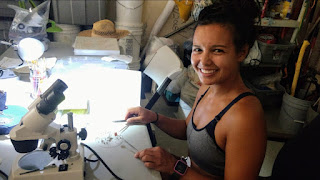Johnston is a nesting ground for 14 pelagic seabird species and 5 wintering shorebird species. Obviously humans were directly responsible for the original decrease in seabird populations, simply because they were killed as a result of most JA operations. Less obvious at the time was the impact of pollution, which was brought to attention much earlier than the problem of invasive, specifically ants and the YCA. Red Tailed Tropic Birds - RTTB nest on the ground under trees, shrubs, up turned rootballs, or rock outcrops. They are ridiculously clumsy and are often seen crash landing some distance from their nests and then using their tiny webbed feet (reminds me of penguin feet) to flop around on their keel, the large ridge of bone that has developed where our sternum is. They also tend to "scorpion" or have their rear end roll up over their head, flinging their tail feathers forward and smoothing their beaks into the ground when they land with force. This usually hap...
